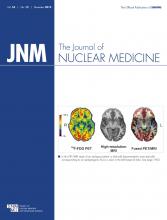Abstract
Noninvasive radionuclide imaging has the potential to identify and assess mechanisms involved in particular stages of lung injury that occur with acute respiratory distress syndrome, for example. Lung uptake of 99mTc-hexamethylpropyleneamine oxime (HMPAO) is reported to be partially dependent on the redox status of the lung tissue whereas 99mTc-duramycin, a new marker of cell injury, senses cell death via apoptosis or necrosis. Thus, we investigated changes in lung uptake of these agents in rats exposed to hyperoxia for prolonged periods, a common model of acute lung injury. Methods: Male Sprague–Dawley rats were preexposed to either normoxia (21% O2) or hyperoxia (85% O2) for up to 21 d. For imaging, the rats were anesthetized and injected intravenously with either 99mTc-HMPAO or 99mTc-duramycin (both 37–74 MBq), and planar images were acquired using a high-sensitivity modular γ-camera. Subsequently, 99mTc-macroagreggated albumin (37 MBq, diameter 10–40 μm) was injected intravenously, imaged, and used to define a lung region of interest. The lung-to-background ratio was used as a measure of lung uptake. Results: Hyperoxia exposure resulted in a 74% increase in 99mTc-HMPAO lung uptake, which peaked at 7 d and persisted for the 21 d of exposure. 99mTc-duramycin lung uptake was also maximal at 7 d of exposure but decreased to near control levels by 21 d. The sustained elevation of 99mTc-HMPAO uptake suggests ongoing changes in lung redox status whereas cell death appears to have subsided by 21 d. Conclusion: These results suggest the potential use of 99mTc-HMPAO and 99mTc-duramycin as redox and cell-death imaging biomarkers, respectively, for the in vivo identification and assessment of different stages of lung injury.
Footnotes
Published online Oct. 19, 2012.
- © 2012 by the Society of Nuclear Medicine and Molecular Imaging, Inc.







